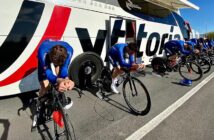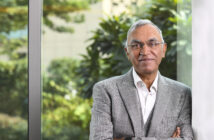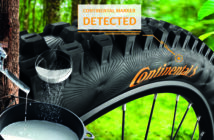With increasing societal concern about both the environmental and health impacts of tire road wear particles (TRWP), Tire Technology International recently spoke with Frederic Biesse, fellow for tire physics and modelization at Michelin, to find out more about his conference presentation at Tire Technology Expo in Hannover: A dive into tire road wear particles. Frederic will be speaking on Day 1 (Tuesday, March 21) as part of the ‘Creating a Circular Economy – Sustainable, Recycled Materials and Pyrolysis’ session.
What is your presentation about?
FB: The study that will be presented at Tire Technology Expo aims to analyze the tire contribution to air pollution, which is a major concern in urban areas. It is often mentioned that vehicle exhaust emissions are reducing and will continue to do so, because of the deployment of electrical vehicles, which questions the non-exhaust emissions (particles from brake, tire, clutch, etc). Thus it is important to have a better knowledge of the airborne particle emissions of the tire, to support efficient analysis of the air quality question and the possible strategies for its improvement. Continuing from last year’s presentation, we have deepened our analysis of tire airborne particle emission, looking at the number of particles emitted in the nano range (below 0.1µm), in the fine particle range (0.1µm to 2.5µm) and in the coarse range (2.5µm to 10µm). Several improvements have been made in the test protocol, especially the analysis of driving severity and its impact on tire emissions, as well as the measurement of the background particle which will be compared with the tire emissions.
How does studying tire road wear particles contribute to the longevity of the tire and a circular economy?
FB: Tire longevity and tire road wear particles are intimately linked: in normal usage conditions, all the tread loss comes from the TRWP generation and emission (not only the airborne particles, but also the bigger ones, 100µm in average, which constitutes the majority of the tire mass loss). To reduce TRWP emission, you have to develop tread materials and sculpture that reduce abrasion rate. By having a lower abrasion rate, you can achieve a longer longevity with the same amount of tread.
What developments in TRWP have been made in the past year by Michelin and what does the company expect for the years ahead? What innovations have resulted from Michelin reducing tire road wear particles?
FB: Irrespective of developments in knowledge that can enable us to better understand the scope and risks linked to tire abrasion, Michelin has been committed to reducing the phenomenon of abrasion for many years, by leveraging its materials expertise and a design strategy focused on optimizing the use of the material.
Between 2015 and 2020, this policy resulted in reducing the TRWP emissions of its products by 5%. Worldwide, it helped to reduce Michelin’s TRWP emissions by approximately 100,000 cumulative tons. As an illustration, our last two tires have improved performance in this domain by 20-25% – Michelin Pilot Sport 5: 25% lower particle emissions versus Michelin Pilot Sport 4; and Michelin e.Primacy: 20% lower particle emissions versus Michelin Primacy 4.
Michelin comes out on top during the testing of around 100 tires by ADAC, the German Automobile Club (study published in December 2021; summer, winter and all-season tire tests). It should also be noted that the study highlights that performance in terms of particle emissions does not undermine other Michelin tire performances.
Why is studying tire road wear particles a priority for tire companies?
FB: It is in the DNA of the Michelin Group and an integral part of its strategy to take due account of the environmental impact of its activities. For several years, the Group has paid particular attention to all scientific studies conducted in the field of TRWPs and to all the issues raised by wear particle emissions for the planet.
How are you contributing your expertise in modeling and simulation to the knowledge of TRWP?
FB: The mission of my department inside the Michelin Research Centre is to have the highest knowledge and expertise in tire physics, tire measurement and tire modelization and prediction. Understanding what mechanisms are at play, what the influencing factors are (both from the tire and from all the external factors, such as the vehicle, the driver, the road, the meteorological conditions), is vital to build a relevant test protocol that succeeds in removing or at least minimizing, external influences. Indeed, for such research, the objective is to exhibit the effect of the tire and not the effect of external factors. It is well known that for tire abrasion, the driving style has much more influence on abrasion and mass loss rate than the other parameters. If we want to measure the tire effect and not the driver effect, it has to be placed under control.
What measures and assessments have been documented to reduce the impact of tire wear on people’s health, especially in cities?
FB: Understanding the risks potentially associated with tire emissions is key for Michelin. Even if today, science has shown that TRWP are very small contributors to air pollution, the Michelin group is in favour of establishing regulatory tire abrasion thresholds to limit particle emissions around the world. To this end, Michelin supports the recommendations of the European Commission, Euro 7 standard, to set tire abrasion limits.
The Group is collaborating with its competitors in the European Tyre & Rubber Manufacturers Association (ETRMA) to define a standardized method of measurement (particle emissions in mg/km).
Committed with other industry stakeholders in the TIP (Tyre Industry Project), the Group is also helping to finance independent studies to increase scientific knowledge about TRWPs.
Finally, Michelin continues to carefully track the research being conducted worldwide that could serve to enhance current scientific knowledge.
As the weight of cars increase, for instance with EVs, how is Michelin reducing wear or ensuring tires produce fewer toxic particles?
FB: Again, understanding why some transformation products are toxic to some species and not others is critical to create a substitute that will generate less effects. Finding a replacement of existing products used in tyres will take time. It is why it is important to start with designing tires that emit fewer particles and a regulation removing the least performing tires from the market, as in EURO 7.
For electric vehicles, it is true that increasing the mass of a vehicle increases the abrasion of tires. As explained previously, abrasion and longevity are tire performances that are at the core of Michelin’s approach. Improvements in tire design for abrasion will result in benefits both for combustion engine vehicle and electrical vehicles. In addition to the continuous improvement of the performance of our tires and rubber mixes (including abrasion, grip, rolling resistance), Michelin launched a dedicated research program in 2021 to find innovative solutions aiming at further reducing the abrasion of our tires as well as the environmental impacts of the wear particles.
What is the key message you want to share with the audience at Tire Technology Expo?
FB: Besides the fact that Michelin is committed to progress on the TRWP (in terms of emissions as well as impacts), the key message of this presentation is probably that a very optimized protocol is required to precisely measure the contribution of the tire to air pollution (neither under or over-estimating the contribution). Due to the numerous factors at play (such as particle resuspension from the road, driver’s driving style, background particles), it is difficult to find the right tire influence on airborne particle emissions, and an optimized measurement protocol is needed.
This will be very helpful to properly establish the true contribution of tires to air pollution and correlate direct measurements taken around the world.
Hear from Frederic and over 130 speakers later this month in Hannover. Visit the Tire Technology Expo website to view the updated conference program and to book your pass.





